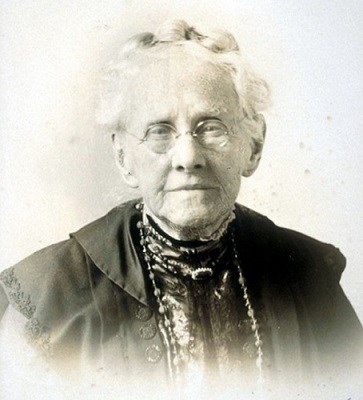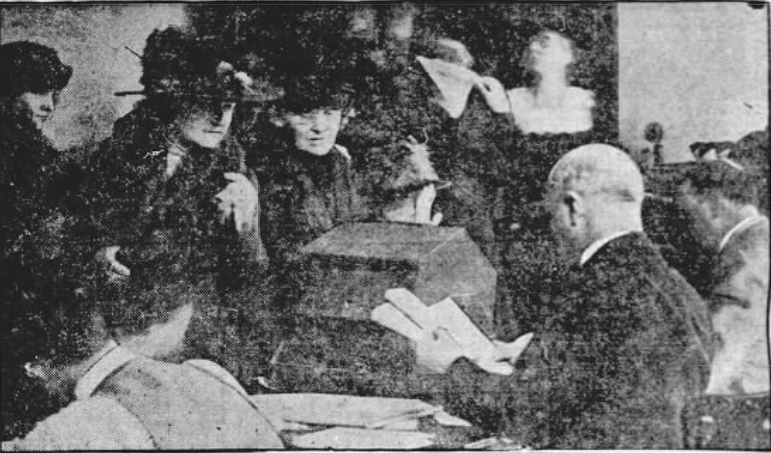Last updated: January 23, 2024
Article
Boston Women Register to Vote
In the months leading up to the 1920 election, Boston women entered their local city buildings and polling locations to register to vote. Mothers waited in line with their toddlers while husbands and fathers assisted their wives and daughters in the process. Traveling with family members, friends, or on their own, each woman showed her earnest desire to obtain her long sought after right to vote.

NPS Photo, Boston City Archives
Diving into the City of Boston's Registers of Women Voters provides a glimpse into the women who registered to vote in their first federal election.[1] While most women may have registered on their own, it appears that many registered in pairs or groups. Numerous women registered with family members—mothers and daughters, sisters, or other family relations with whom they lived. For example, twin sisters and clerks Ethel and Edith Townsend registered together on October 6, 1920.[2] Other women registered alongside neighbors, friends, fellow boarders, or coworkers. Elizabeth Coffey and Margaret St. Lawrence, box makers at the same shop, registered together in Ward 13, while a group of nurses and students at the New England Deaconess Hospital, living at the Nurses' Home, registered in Ward 14.[3] While ties may not always be clear in the records, these examples demonstrate that many women joined together in taking on this new responsibility.
Reinforced by these registries, women of all classes, races, religions, and nationalities took advantage of their new political right. Students, teachers, dressmakers, domestic workers, saleswomen, musicians, attorneys, housewives, Navy Yard workers, and more all signed the registries. While many women had been born and raised in local Boston neighborhoods, other new voters came from nearby New Hampshire and Vermont or migrated from across the United States, including Virginia, Kentucky, the Carolinas, and Illinois. Some of these women may have migrated during the Great Migration, when Black Southerners traveled north to escape racial violence and seek economic opportunities. Officials noticed the eagerness of Black women who, "seem[ed] to appreciate the ballot more than their white sisters." Women who had immigrated to the United States obtained citizenship and the right to vote through their husbands’ naturalization. These women emigrated from countries such as Ireland, Italy, Russia, Canada, the British West Indies, and beyond. Newspaper accounts recognized "Swedes, Lithuanians, Norwegians, and many other women of foreign birth [who] clamored for the new privilege granted by the United States to its women."[4]

Schlesinger Library, Radcliffe Institute, Harvard University
Two Boston women, Annie Stone and Judith Winsor Smith, celebrated living long enough to witness the decades-long fight for the vote. Understanding the significance of this event, both women registered to vote. Living in a home in Roxbury, Annie Stone registered in Ward 16 at the age of 101. A poet with a clear memory, Stone had "a keen interest in the passage of the suffrage amendment, and is well acquainted with political issues."[5] Widely recognized as the oldest active suffragist, Judith Winsor Smith prepared to vote at 100 years old. Remembering the many times she voted in School Committee elections, she expressed new excitement for the prospect of voting in a presidential election, "I am going to register and vote for President if I am allowed. I would not miss it for anything. To cast my first vote for the President at 100 years of age will be honor enough for me."[6] Smith also recognized the duty women had to their foremothers of the suffrage movement: "For 70 years I have been in the fight for woman suffrage, and I want every woman to go to the polls the first election they are allowed to and vote."[7]
On the other hand, not all women who registered originally supported women's right to vote. Even former anti-suffragists reluctantly joined the ranks of new voters to the surprise of city officials. Most of these anti-suffragists held similar perspectives in fulfilling their new responsibility, as one avowed anti-suffragist acknowledged:
I am against equal suffrage, but since the responsibility has been placed on our shoulders we will make the best of it. Voting is now a duty, which we would prefer not to assume, but which we will not shirk.[8]
Some women unsuccessfully tried to register to vote, dashing their dreams of voting in their first federal election. Literacy tests limited access to the vote for numerous women, particularly those of the working class or who had recently immigrated to the United States.[9] To qualify, an applicant had to read selections of the Constitution of Massachusetts.[10] One heart-breaking incident involved a Cambridge woman turned away because of her inability to see well:
One poor old woman in Cambridge was unable to read the slips, even with a magnifying glass. Three officials attempted to help her, but she was unable to meet the test. She went out of the City Building almost crying, when they told her that because of her inability to read she could not vote next Fall. The woman was nearly 80 years old.[11]

Boston Globe, October 12, 1920
Some did not understand election procedure, trying to register at locations other than those closest to where they lived.[12] Thousands of women waited for hours on the last day to register to vote, on October 13, only for election officials to turn them away at the 10 p.m. deadline. Shattered, these women "looked at each other with amazement. Their disappointment was evidently keen."[13] At a polling location in South Boston, 200 women "nearly precipitated a riot" as they voiced their displeasure at election officials and supervising police officers.[14]
Newspaper accounts offered a wide variety of impressions on women registering to vote. In some cases, reporters used sexist tones when describing incidents of women not understanding the registration process. Several articles mentioned women’s hesitancy in providing their age for voter records. These accounts provided comedic and sometimes demeaning anecdotes that demonstrate this hesitancy. Some women gave vague answers, provided false ages first before relenting and acknowledging their true age, or refused to give their age outright.[15] One such article offered a story of a woman in Cambridge registering to vote:
There was only one woman in Cambridge who refused point blank to give her age when asked. Mr. Penniman explained to her that under the laws of Massachusetts she couldn't vote unless she gave her age. The woman, evidently no longer young, glared at him and said with a I-dare-you-to-contradict-me air, "I am 35." "She looked rather old for her years," smiled the registrar.[16]
Despite these comments, most newspapers reported the eagerness and the determination of women to successfully vote and register in elections, "Their intelligent faces, their quick appreciation of what the ballot means, their unswerving intention of making their particular vote help in making this a better country was felt by every registration official."[17]
No matter their age, identity, background, or station in life, many Boston women saw the importance of fulfilling their civic duty to ensure their political voice would be heard.
Learn more about Boston women voting in the 1920 election.
Contributed by: Kaitlin Woods, SCA Public Historian
Footnotes
[1] General observations of women voters are drawn from a review of a selection of the City of Boston’s Registers of Women Voters for Wards 12-16. Special thanks to NPB volunteer Mark for transcribing these registries. Please visit Boston City Archives for access to these records.
[2] City of Boston Register of Women Voters, Ward 16, Volume 1A (pgs. 10-11), Boston City Archives; Edith Townsend, Boston Ward 16, Suffolk, Massachusetts, United States. (Original index: United States Census, 1920, FamilySearch, 2014).
[3] City of Boston Register of Women Voters, Ward 14, Volume 2 (pgs. 10-11), Boston City Archives; City of Boston Register of Women Voters, Ward 13, Volume 2 (pgs. 10-11), Boston City Archives.
[4] Marjory Adams, “How Old are You, Madam?” Boston Globe, August 29, 1920.
[5] “Woman Registers at the Age of 101,” Boston Herald, August 20, 1920.
[6] “She’ll Vote Even if It Rains,” Boston Globe, August 29, 1920.
[7] “She’ll Vote Even if It Rains,” Boston Globe, August 29, 1920.
[8] Marjory Adams, “How Old are You, Madam?” Boston Globe, August 29, 1920.
[9] J. Kevin Corder & Christina Wolbrecht, "Did Women Vote Once they had the Opportunity?" American Bar Association (December 2, 2019). Last accessed October 2020, https://www.americanbar.org/groups/public_education/publications/insights-on-law-and-society/volume-20/issue-1/did-women-vote-once-they-had-the-opportunity-/
[10] Marjory Adams, “How Old are You, Madam?” Boston Globe, August 29, 1920.
[11] Marjory Adams, “How Old are You, Madam?” Boston Globe, August 29, 1920.
[12] “Registration Record of City Broken when 9468 New Voters are Added,” Boston Herald, October 12, 1920.
[13] “Registration Records Broken with 200,000; 10,000 Arrive Too Late,” Boston Herald, October 14, 1920.
[14] “Registration Records Broken with 200,000; 10,000 Arrive Too Late,” Boston Herald, October 14, 1920.
[15] “Wanted to ‘Vote Now,’” Boston Herald, August 20, 1920; Marjory Adams, “How Old are You, Madam?” Boston Globe, August 29, 1920; “Registration Record of City Broken when 9468 New Voters are Added,” Boston Herald, October 12, 1920.
[16] Marjory Adams, “How Old are You, Madam?” Boston Globe, August 29, 1920.
[17] Marjory Adams, “How Old are You, Madam?” Boston Globe, August 29, 1920.
